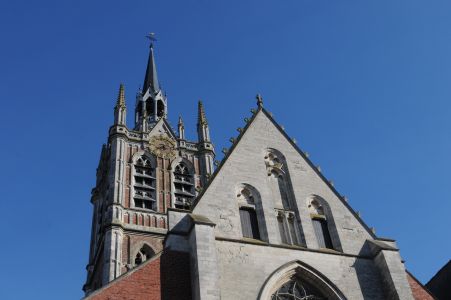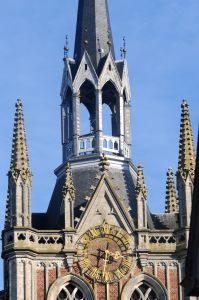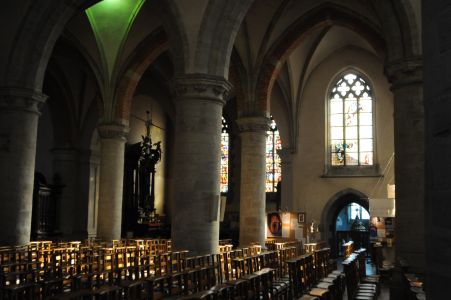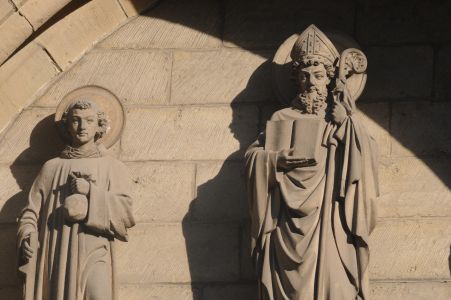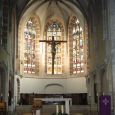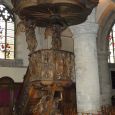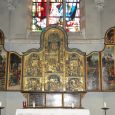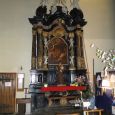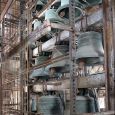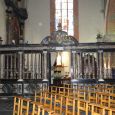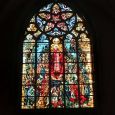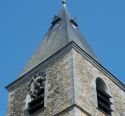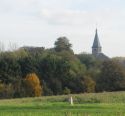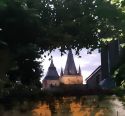Church | 1310-1848 | Neogothic | Catholic Church



Map
Opening hours
01 January - 31 December
Mon 9.30 - 17.00
Tue 9.30 - 17.00
Wed 9.30 - 17.00
Thu 9.30 - 17.00
Fri 9.30 - 17.00
Sat 9.30 - 17.00
Sun 9.30 - 17.00
Chapel Our Lady of Messina :
Monday - Tuesday - Thursday - Friday : 6 pm - 7 pm
Religious offices
Saturday 5.30 pm
Sunday 11 am
EgliseInfo
Description
Although the origins of the church are little known it is certain that the main altar was consecrated in1347.Throughout the centuries the building has been sacked and burnt several times but fortunately it was restored to its original state during the 1960’s.
The Brabant style Gothic tower stands out with its ringing carillon. This is one of the oldest in Belgium with its 51 bells, of which the oldest dates from 1566. The small houses that used to surround the church have been cleared away. It was through these that the Dukes of Arenberg used to attend services so as not to mix with the common crowd. One can see here and there in the church the place that noble families like the Arenbergs, the princes of Croy and more recently the Empains occupied in Enghien.
There are several noteworthy items in the church, the most important being the superb 16th century altar piece from Antwerp in the chapel of Our Lady of Messina. In a series of detailed carved scenes this altar piece tells the story of Mary from the conception of her child and other episodes such as the visit of the three wise men, the circumcision and the assumption. It is worth taking the time to look at this closely as it tells a story in pictures. There are also numerous stained glass windows, some old and some contemporary by Max Ingrand (1964).There are some 15th century statues, baptismal fonts and a fine pulpit.
Photos
Remarkable elements
Choir and stained glass windows
Built by the d'Enghien family, rebuilt by the Luxembourg family, it bears their coat of arms on the keystones.
Six stained glass windows decorate the choir and evoke the martyrdom of St. Sebastian and the unsuccessful assault of the States against the city of Enghien in 1580, the martyrdom of St. Lawrence and the procession organized in his honor (1580), the beheading of St. John the Baptist and the legendary discovery of his statuette floating on the water in the suburbs of Enghien in 1399, the visit of the workshop of a fèbre by St Eloi and the renewal of the privileges of the Brotherhood of St Eloi by the lord of Enghien in 1431, the crowning of the Virgin and the resurrection by St Nicolas, of the three children in the salt cellar...
Pulpit of Truth
Pulpit of Truth (17th century): leaning on the Faith, the octagonal bowl is decorated with the four evangelists separated by cherubs; at the foot of the ramp, Saint Peter and Saint Paul. Above the main entrance, Max Ingrand's large stained glass window evokes the Apostolate (1964). In the rose window, the attributes of the apostles; in the center Christ sends the Christians throughout the world; Apotheosis of faith, hope and charity... Remarkable stained glass by the size and density of the subject as well as by the richness of the colors.
Chapel Notre-Dame de Messines and her altarpiece
The church of St-Nicolas once had several chapels. Three of them remain, the oldest of which is the Chapel of St. Eloi (early 12th century), known under the name of ND de Messines. The members of the Confrérie de St Eloi, one of the oldest and richest in the city, used to meet there (13th century). The stained glass windows by Max Ingrand (1962) represent the Nativity, the Wedding of Cana, the Calvary and the descent of the Holy Spirit. The splendid Altarpiece of the Virgin, classified as a Treasure, marked with the hallmark of Antwerp and attributed to the sculptor Moreau, features one hundred and twenty-five characters. The predella evokes the tree of Jesse. The central part contains scenes from the life of the Virgin Mary.
Chapel Saint Anna and her ceiling
In this chapel met the members of the Chamber of Rhetoric, called Confrérie de sainte Anne. The splendid armorial stucco ceiling (1690) includes a dove representing the Holy Spirit between the coat of arms of the city of Enghien and the emblem of the Rhetoricians; then, between the coat of arms of the Duke of Arenberg and his wife, a basket and thoughts illustrating the motto of the Rhetoricians ("Penser y fault"); in the center, a tree taking root in the bosom of St. Anne, patroness of the Brotherhood and mother of the Blessed Virgin; at the top, the child Jesus holding a cross and a thought. The stained glass windows (1930-1931) evoke the story of the stolen and perforated hosts...
The church bells (bell tower)
The tower of the church had a carillon since the end of the 14th century. Restored and completed several times (in 1756, 1925 and 1955), it includes fifty-one bells. The clock dials and the drum of the automatic bronze carillon date from 1765 (Duméry). The mechanism was electrified in 1989. A complete restoration of the numerals and dials was carried out in November 2013.
The chapel of Our Lady of the Rosary
The chapel of Our Lady of the Rosary (1634) is due to the generosity of the Duchess Anne de Croy whose coat of arms decorates the balustrade of 34 red marble columns. The panels were made after the doors of a similar balustrade in the church of St. James in Antwerp. The painting attributed to Antoine Van Huvelle (1635) depicts the Virgin Mary holding the infant Jesus and offering the rosary to St. Dominic. Kneeling, the Duchess Anne de Croy whose coat of arms adorns the pediment of the altar. The communion bench (17th century) and the confessional (17th century) come from the chapel of the former beguinage of Enghien.
Stained glass window
Above the main entrance, Max Ingrand's large stained glass window evokes the Apostolate (1964). In the rose window, the attributes of the apostles; in the centre, Christ sends Christians throughout the world; an apotheosis of faith, hope and charity... Remarkable stained glass window by the size and density of the subject as well as by the richness of the colours.
Nearby
Circuit
The Middle Ages in the Haute Senne region (from Steenkerque to Enghien)
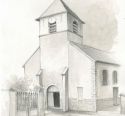
In Steenkerque, home of Guillaume de Gavres, the church will observe your actions. You will then pass on the road to Petit-Enghien before arriving in the medieval city of Enghien. You will meet Jonathas, Saint-Éloi and local lords.
The Middle Ages in the Haute Senne region (full circuit)
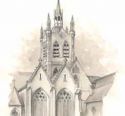
Proudly erected for centuries, churches are witnesses to local history. With castles and farms, they tell about an era and its customs. Are you more of a car person? Our fourth route offers you all the buildings in the program. A great way to learn everything about the region!



